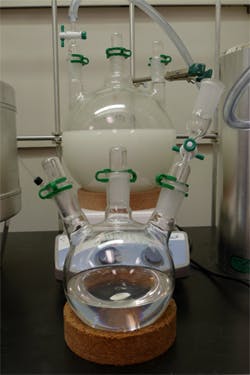Since moving its operations to Baltimore in 2011, nanocrystal additive manufacturer, Pixelligent Technologies, has seen the kind of explosive growth and market success that seems only possible in business school fantasies and start-up legends.
In these past 17 months, the company has seen its customer pipeline increase tenfold and has grown to include some of the world's largest chemical-polymer manufacturing companies, prompting a 150% increase in its workforce and an expansion to a 13,000-square-foot facility.
According to CEO Craig Bandes, though this success appears to have struck fast, it has been long in coming for the industry.
"For ten years, people have been saying nanotechnology is going to hit next year," he joked. "Well, now it is actually happening and these companies are finally seeing that nanotechnology is real -- that it is having real, significant impacts in a number of different technologies and products."
- Craig Bandes, CEO, Pixelligent Technologies
Of course, this newly realized and matured technology wouldn't mean much without a receptive market. Luckily, today's manufacturers seem very much in the mood for progress.
"In the industrial world, there is a real focus now on how to incorporate next-generation materials into what they are doing today," he explained. "There is a convergence going on between a receptive market that is out there looking for nano-enabled solutions and companies like Pixelligent that have cracked the code on the technology."
This convergence is translating into what many are calling a "nanotech revolution," as the long-awaited mainstream adoption of the technology finally takes hold.
For Pixelligent, this has meant some impressive growth both in the market and in their production process.
"Going back two years, we were working with 100 milliliter reactors," Bandes recalled. "But any minute now we're going to have our first 30 gallon reactor arrive, and we expect from there we'll go up into hundred-gallon-sized reactors."
This growth speaks much about the quality of the company's products and processes, but the market boost Bandes is describing isn't exclusive to Pixelligent alone. IndustryWeek recently reported on a partnership between Nanocomp Technologies and DuPont (IW 500/36) that highlights this same trend, for example, and there are plenty of other stories around to give it credence.
What is driving all of this, Bandes explained, is the long-awaited alignment of the market's need and the technology's supply.
Next-Generation Solutions for Next-Generation Technologies
"Semiconductors have gone from a 22 nanometer node down to a 14 nanometer, and now a nine nanometer node. They need new materials and technologies to get them there," Bandes explained.
"And also, for flat screen displays and LEDs, how do you continue to make devices smaller and thinner yet still improve the clarity and the battery efficiency?" he asked. "They need next-generation solutions for that."
The problem for these large companies, however, is that they lack the research funds to develop those technologies on their own.
"There has been a significant decrease of R&D dollars not only with large material manufacturing companies here in the U.S., but really across the board because of the challenges to the global economy these past five to seven years," he explained. "They just couldn't justify making those internal investments."
This has left these companies scrambling to find ways to develop the materials and technologies they need to meet the market demands.
At this point, Bandes suggestsed it would take these companies far too long to develop quality technologies on their own, so they are finding ways to work with companies like Pixelligent that can bring them the high quality, scalable technology they need.
And this, he said, is the story behind the "revolution."
Finding a Competitive Edge
Of course, the nanotechnology industry is extremely diverse, so stories about growth and maturation shouldn't be applied too broadly. There are simply some technologies that are a little further ahead than others.
According to Bandes, the key discriminator defining which nano companies are best profiting from this market upsurge is ease of application they can sell to their customers.
"There are still a fair amount of nano companies that still think that large companies are going to change what they are doing for them," he said. "But our experience tells us that just isn't going to happen. You have to find out what they are doing and find a way to drop it into where they are headed."
Doing this, he said, is exactly what has pushed Pixelligent ahead.
Pixelligent's nanocrystals are delivered to customers in liquid form. The additives seen here are going through the nanocrystal surface modification process and will eventually be used to improve several optical, mechanical and chemical properties of the customer's products.
Unlike many nano companies, Pixelligent uses a wet synthesis process to create its nanocrystals, which bypasses a lot of the environmental health and safety issues involved with powder carbon nanotubes and results in a product that can be dropped into customers' solvents without further engineering.
"Our technology is a drop-in, so there are no changes our customers have to make to their own manufacturing process or their equipment to start using it," he said. "They may need a little less of it, they might need a little more, but it can move seamlessly into what they are doing today and what they want to do in the future."
Beyond that, he says, the most important thing that nano companies can do is perfect their technologies and get them into the hands of customers... though not necessarily in that order.
"What I always tell entrepreneurs is, don't sit back for too long in a dark room trying to perfect your product and then bring it to the marketplace. You are very rarely right without customer input," he said.
"We've had a lot of success by getting out in front of customers early, showing what our technology can do and having them tell us where it can help them. Because of that you can get a lot of knowledge about where the technology has the most potential -- about where it can play into the market that can afford to use it."





